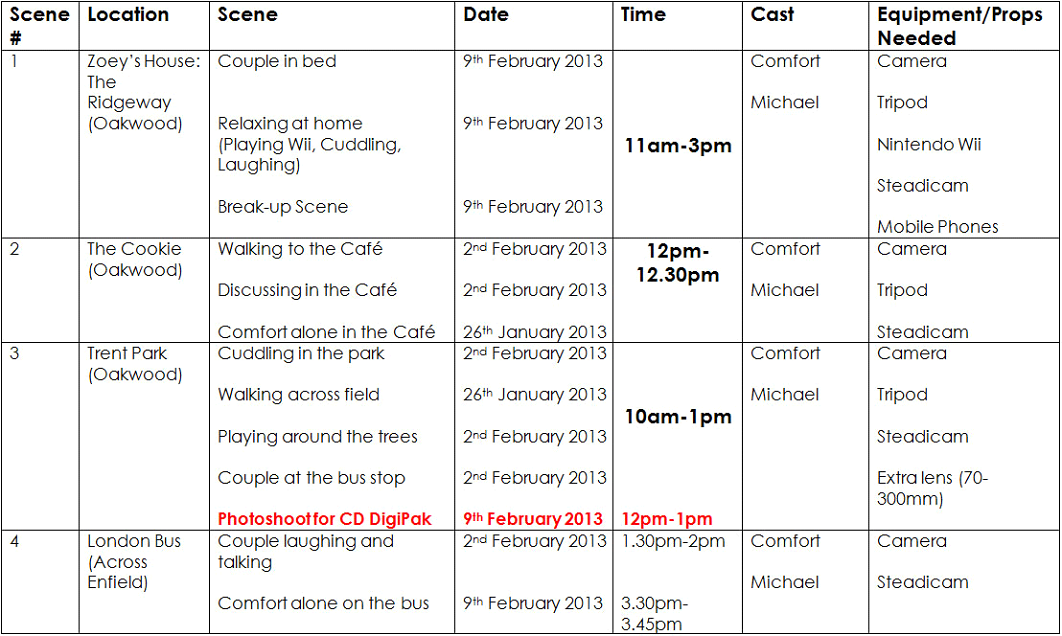Creating the Production Schedule
When preparing to create a promotional video, marketers often feel a bit lost. There are numerous factors to be included and lining up everything that needs to be done in a production schedule helps in navigating such a process.
Before the video is ever shot, production scheduling is used to organize and plan for the shoot day. Having this schedule helps move along the production process and helps to ensure that you are satisfied with the end result.
The schedule is used to not only make sure the shoot runs smoothly, but also that the time and budgetary goals are met. Although every project is different and has its own specifications, a few basic phases are present in every one of them. In this checklist, we will provide the reader with tips on how to make a production schedule for a film, including the factors that are necessary for success.
You can find a simple production schedule sample at Marianne Media's Blog

Lining the script
First of the crucial steps is lining the script. By that, we mean building and organizing the script in terms of each shoot by drawing lines on the script separating them out. Many elements will be on the script, including the cast, wardrobe, props and special equipment.
This process just gets easier with the help of a pre-production schedule template. For a more technical and detailed breakdown, you can download a video shoot schedule template from freescheduletemplates.com or template.net. Small Business Supply Chain has even created a video teaching how to create a production schedule using Excel.
Breaking the script into breakdown sheets
The next step in production planning and control is organizing and categorizing the factors into separate sheets. An example of a breakdown sheet would include separate pages for each scene, each including an explanation of the scene number, the location or environment, the cast needed, any audio effects, etc.
Scouting and securing a location
The location plays a huge part in your video. Take photographs of the intended sites during the pre-production process. Making a detailed list of all the possible indoor and the outdoor places beforehand will help determine the best location for your shoot. The photos you're going to make can be added to the breakdown sheets.
Once the photographs and the list of the locations are made, examine which of those are available at any time and which require special permissions. For more help in choosing the right place to shoot, check out these tips for scouting a location.
Getting a crew together
The shooting requires specific personnel, including a director, camera operators, lighting and sound technicians, and runners. All the details of your crew can be listed in your film production schedule template.
Utilizing a number of talented professionals may not always be the best option if your small business has a modest budget. Nevertheless, the more experts you can add to your production team, the higher quality footage and video material you will get. You may also find a crew member who is looking to build their portfolio; they may be willing to gain experience by offering you a lower rate than a more established professional would charge.
Casting actors or presenters
Your film shooting schedule will contain a list of available actors or presenters. Casting can be a tricky task: age-inappropriate and novice actors often lead to the collapse of a video. Try putting up flyers, asking a local theater, or contacting acting class instructors to find suitable people for the particular role. Spend time analyzing each person's performance and decide which one is most fitting.
If you have difficulty casting actors, be sure to read Rodypolis' indepth look at how to find actors.
Organizing Equipment
It is essential to know how many cameras and what type of lenses, lights, and audio devices you'll be using. Video production equipment can be costly, but if you find a professional who has his own apparatus to rent, you're on the right path to significantly minimizing costs.
Furthermore, you can use your own device and make it into a shooting tool, for example, converting an iPad into a teleprompter.
Acquiring all necessary licenses and permissions
Even if you shoot at a public location, you're at the risk of having it cancelled by the police if a complaint is made. You must obtain all permits and licenses from the local film office and city officials prior to the shoot.
Writing the call sheet
The call sheet, or timed plan of filming, has to be included in the production schedule. You have to make sure the shoot dates do not overlap and that every person knows when to arrive at the scene. For the call sheet, it helps to be using a production calendar template.
Your prop list
Props are the things actors interact with. Having a list ahead of time helps determine which props are already on hand and which need to be rented or borrowed. A note to the placement of each prop for each scene is usually found in the script breakdown.
Scheduling special effects
Using special effects can be a costly venture, so if a small budget is required, listing all the desired special effects and choosing one or two of them can help keep you under budget. Kissmetrics.com offers many options for creating low cost yet effective special effects.
Conclusion
Now you have a better understanding of what goes into making a film and how to create a production schedule to create your next successful marketing video. One last tip is to visit Yamdu, a film production scheduling software which combines the tools for all phases of your video production. They offer a free, 60-day trial during which you can easily learn the ins and outs of video shoot scheduling.






